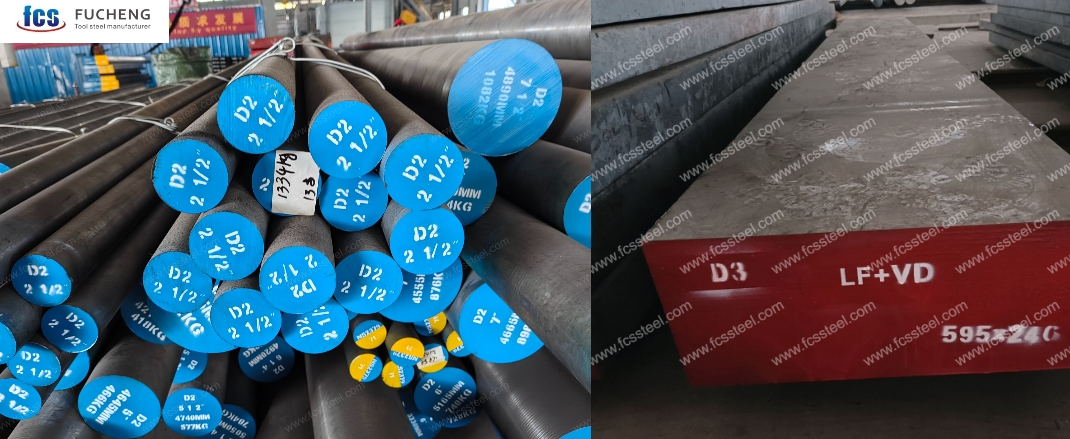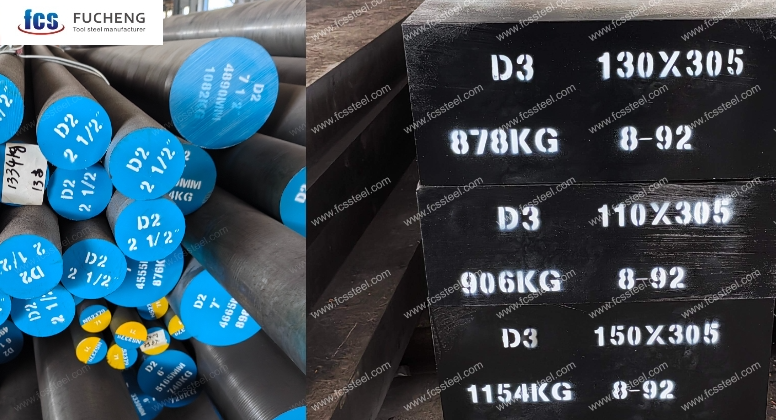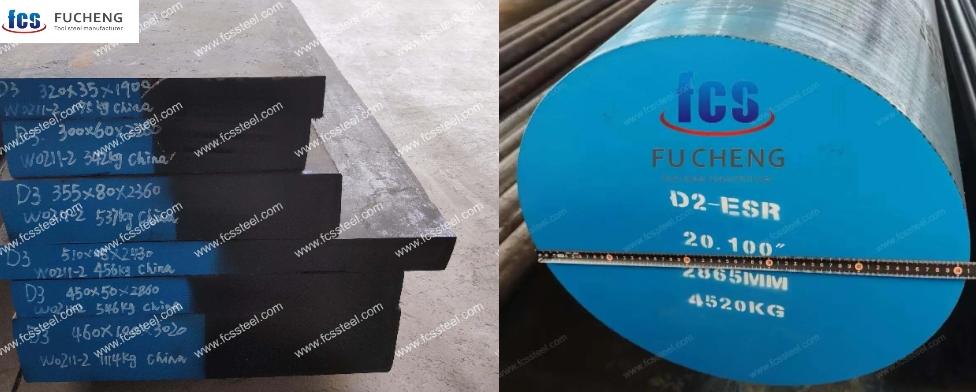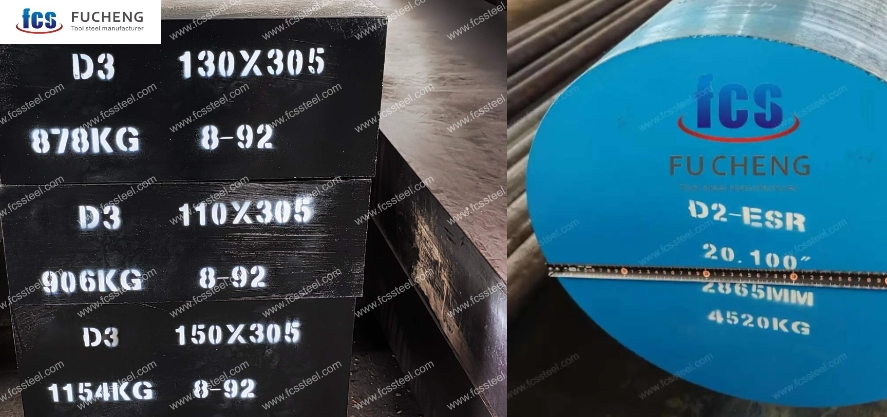Germany is home to one of the world’s most sophisticated mould and die industries, known for precision engineering, automated production, and strict metallurgical standards. Within this ecosystem, the selection of tool steel plays a critical role — especially in cold work applications, such as stamping, blanking, and forming.
Among the most commonly used cold work tool steels are D2 steel (1.2379 steel / X153CrMoV12 steel) and D3 steel (1.2080 steel / X210Cr12 steel). Though they share a high carbon and chromium base, their microstructures and mechanical behavior differ significantly, leading to distinct performance outcomes in industrial use.
This article explores — with technical evidence and practical insight — how D2 and D3 compare in wear resistance, toughness, cost, and thermal stability within German mould manufacturing environments.
1. Composition and Metallurgical Differences

Both D2 and D3 belong to the high-carbon, high-chromium cold work tool steel family under the DIN standard. Their similarities often cause confusion, but a closer look reveals key differences that influence performance.
| Property / Element | D2 (1.2379) | D3 (1.2080) |
|---|---|---|
| Carbon (C) | 1.40%-1.60% | 2.00%-2.30% |
| Chromium (Cr) | 11.00%-13.00% | 11.00%-13.50% |
| Molybdenum (Mo) | 0.20%-0.60% | 0.20%-0.60% |
| Vanadium (V) | 0.50%-1.10% | ≤1.00% |
| Manganese (Mn) | 0.20%-0.60% | 0.40% |
| Silicon (Si) | 1.00%-1.60% | 1.00%-1.60% |
| Hardness (after heat treatment) | 58–62 HRC | 60–64 HRC |
Key takeaway:
D3 contains more carbon but lacks molybdenum and vanadium, leading to higher hardness and wear resistance, but lower toughness. D2, with Mo and V additions, achieves a better balance between strength and toughness, making it more adaptable to dynamic loads.
2. Performance in German Cold Work Applications
In Germany’s DIN 17350 and ISO 4957 standards, D2 and D3 are classified as cold work tool steels for cutting and forming dies. However, their practical applications differ depending on operation type and stress profile.
| Application Type | D2 (1.2379) Typical Use | D3 (1.2080) Typical Use |
|---|---|---|
| Punching dies | ✓ Frequent | ✓ Occasional (for thin sheets) |
| Blanking dies | ✓ | ✓ |
| Forming dies | ✓ | — |
| Shear blades | ✓ | ✓ |
| Cold extrusion dies | ✓ | — |
| Drawing tools | ✓ | — |
| Roll forming tools | ✓ | — |
In German stamping plants, D2 tends to be favored for complex die shapes and multi-stage presses, while D3 remains competitive for straight, abrasion-dominated applications.
3. Wear Resistance vs. Toughness

3.1. Wear Resistance
D3, with its 2.1% carbon content, forms a denser chromium carbide network, resulting in exceptional wear resistance in low-impact conditions.
Testing by European tool steel research institutes (e.g., IFW Hannover) shows D3 exhibits 10–15% better abrasive wear resistance than D2 under dry sliding conditions.
3.2. Toughness
However, D3’s superior hardness comes at the cost of toughness. When exposed to impact or shock loads, D3 tools are more prone to microchipping or cracking.
D2’s molybdenum and vanadium carbides improve impact toughness by 30–40%, making it the preferred choice for pressing thicker or high-tensile materials.
| Property | D2 | D3 |
|---|---|---|
| Wear Resistance | High | Very High |
| Impact Toughness | Good | Fair |
| Edge Stability | Excellent | Moderate |
| Heat Crack Resistance | Better | Lower |
Conclusion:
In high-volume stamping environments common in Germany’s automotive and appliance sectors, D2’s toughness advantage often outweighs D3’s marginal wear benefit.
4. Heat Treatment and Dimensional Stability
Heat treatment is a decisive factor in tool steel performance, especially in precision mould manufacturing.
| Step | D2 (1.2379) | D3 (1.2080) |
|---|---|---|
| Preheat | 850–900°C | 850–900°C |
| Austenitizing | 1020–1040°C | 970–1000°C |
| Quenching | Air / Vacuum | Air / Oil |
| Tempering | 500–550°C (2–3 cycles) | 150–200°C (1–2 cycles) |
Because of D2’s air-hardening and secondary hardening ability, it offers superior dimensional stability — critical for German toolmakers producing close-tolerance dies for high-precision stamping.
D3, while capable of reaching higher surface hardness, experiences greater distortion risk due to oil quenching and lacks the secondary hardening response of D2.
5. Cost and Machining Considerations
| Factor | D2 | D3 |
|---|---|---|
| Raw Material Cost (2025 Germany) | €3.20–3.40/kg | €3.00–3.10/kg |
| Machinability Index (AISI 1212 = 100) | 50 | 35 |
| Heat Treatment Cost | Moderate | Lower |
| Grinding Difficulty | Moderate | High |
D3 may appear cheaper initially, but in German manufacturing — where machining precision, rework reduction, and tool longevity are priorities — D2 often yields lower total cost of ownership.
Additionally, D2’s better grindability supports CNC profile grinding and EDM finishing — both common in Bavarian and Baden-Württemberg mould workshops.
6. Cold and Thermal Stability in Production

One of the decisive parameters for cold work steels is thermal stability, especially under fluctuating temperatures during stamping or shearing.
- D2 Steel: Maintains hardness up to 500°C; minimal dimensional change upon cycling between ambient and operational temperatures.
- D3 Steel: Begins to lose hardness around 480°C; more susceptible to thermal fatigue cracking.
This makes D2 ideal for precision, repeat-cycle applications in Germany’s automated tooling lines, where tool temperature may rise during extended press operation.
7. Practical Case Studies in German Cold Work Manufacturing
While confidential commercial data are restricted, generalized performance results from German industrial test reports (VDMA 2024–2025) show:
| Test Condition | Material | Tool Life (Cycles) | Failure Mode |
|---|---|---|---|
| Mild steel stamping (DC01, 1 mm) | D3 | 280,000 | Edge microcrack |
| Mild steel stamping (DC01, 1 mm) | D2 | 340,000 | Mild abrasive wear |
| Stainless stamping (AISI 304, 1.2 mm) | D3 | 190,000 | Cracking |
| Stainless stamping (AISI 304, 1.2 mm) | D2 | 260,000 | Wear rounding |
Result: D2 shows a 20–35% longer tool life in modern German press systems under variable temperature and impact loading conditions.
8. Environmental and Sustainability Considerations

The German steel industry places strong emphasis on energy efficiency and recycling.
From a sustainability standpoint:
- D2, containing molybdenum and vanadium, has a slightly higher alloy footprint, but its longer life cycle compensates through reduced replacement frequency.
- D3’s high carbon content can lead to increased carbon emissions during melting and refining, though it consumes less molybdenum.
German suppliers are increasingly sourcing from electric arc furnace (EAF) production routes, lowering CO₂ per ton by up to 30% compared with traditional blast furnace methods.
In China, companies such as FCS Tool Steel (Fucheng Tool Steel), based in Huangshi, Hubei, have also adopted cleaner vacuum-melting technologies aligned with EU sustainability standards, offering certified D2 and D3 grades suitable for export to the German market.
9. Choosing Between D2 and D3 for German Conditions
| Criteria | Preferred Steel | Reason |
|---|---|---|
| High wear, low impact | D3 | Superior carbide density |
| Balanced wear and toughness | D2 | Molybdenum–vanadium alloy balance |
| Tight dimensional tolerance | D2 | Air-hardening and low distortion |
| Low-cost, small-volume production | D3 | Cost advantage |
| Long service life & regrindability | D2 | Toughness + secondary hardening |
Summary:
For most modern German mould shops, D2 (1.2379) has become the default cold work tool steel, while D3 (1.2080) remains useful in legacy dies and abrasive cutting tools where cost is a primary factor.
10. Conclusion
In Germany’s evolving cold work manufacturing landscape, both D2 and D3 maintain important roles.
However, as automation increases and tolerance requirements tighten, D2’s toughness, dimensional stability, and versatility make it the superior long-term choice for precision stamping and forming.
When sourced from reputable, internationally certified producers such as FCS Tool Steel (Fucheng Tool Steel) — a leading supplier from Huangshi, Hubei — D2 can offer consistent metallurgical quality, reliable hardness uniformity, and improved performance tailored to German mould-making standards.
Ultimately, the D2 vs D3 decision in Germany is not about choosing the “hardest” steel, but the most balanced and sustainable one — capable of meeting the precision, durability, and environmental expectations of Europe’s manufacturing future.
